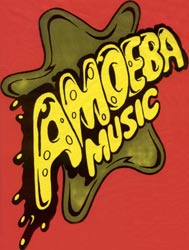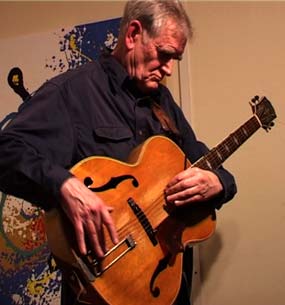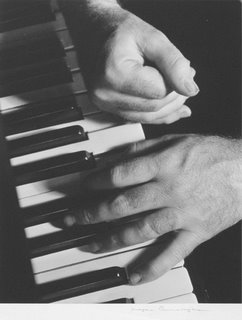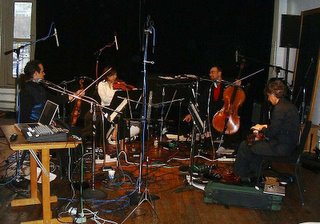 The B Whole-tone (2 - 1) mapped to the Square-root-of-2 Scale.
The B Whole-tone (2 - 1) mapped to the Square-root-of-2 Scale.
Saturday, December 31, 2005
Friday, December 30, 2005
The Standing Room for a Day
 Never judge a blog until you've walked in Hollywood while legally parked. In the grand tradition of the Amoeba Run - as practiced at The Standing Room - HurdAudio is "singing and parking in LA" as I do my best M.C- impression in SoCal style.
Never judge a blog until you've walked in Hollywood while legally parked. In the grand tradition of the Amoeba Run - as practiced at The Standing Room - HurdAudio is "singing and parking in LA" as I do my best M.C- impression in SoCal style.For anyone sadly uninitiated - or even more sadly out of range to experience California's finest retail experience - Amoeba is more than just a single-celled organism. It's also a CD mecca for serious collectors on the left coast who aren't afraid to get their hands dirty sifting through massive quantities of used inventory. I've been to all 3 Amoebas at one time or another and unearthed some serious sonic treasures at each. There's nothing better than having a "home town" Amoeba and I have no complaints about the one on Sunset Boulevard in Hollywood, California. With fresh gift certificates in hand from the holidays this was a good day to be in tinsel town.
 Don Byron: Ivey-Divey. This one made a lot of Best-of lists in 2004. And with Jack DeJohnette working the kit and Jason Moran on the piano I have high expectations.
Don Byron: Ivey-Divey. This one made a lot of Best-of lists in 2004. And with Jack DeJohnette working the kit and Jason Moran on the piano I have high expectations.Don Byron: You Are #6 - More Music for Six Musicians. This is a group I saw play at the Experience Museum in Seattle a few years ago. This is a follow-up to the excellent Music for Six Musicians.
John Cage: Music for Prepared Piano, Vol. 2 performed by Boris Berman. A fine Naxos disc that opens with "The Perilous Night."
John Cage: Three Constructions performed by the Donald Knaack Percussion Ensemble and Jay Clayton on voice. I've heard all three "constructions" performed live at various times and it's good to finally get a recording into my collection. The program looks interesting. Between the constructions are inserted a pair of vocal works I'm not familiar with: "A Flower" (1950) for voice and closed piano and "Forever And Sunsmell" (1942) for voice and percussion duo. All these works are from a particularly fertile creative period from 1939 - 1950 in Cage's output.
Cornelius Cardew: The Great Learning Paragraph 2 & 7/David Bedford: Two Poems for Chorus on Words of Kenneth Patchen. I don't know much about David Bedford, but he's in good company on this disc as I picked it up for the amazing Cornelius Cardew and his Scratch Orchestra performing this "The Great Learning."
Cornelius Cardew: Piano Music 1959 - 1970 performed by John Tilbury. Another Matchless Recordings documenting Cardew's music.
 Dave Douglas: Strange Liberation. The last of the RCA-Victor label Dave Douglas and the only one I didn't pick up the day it was released. Long live Greenleaf Music.
Dave Douglas: Strange Liberation. The last of the RCA-Victor label Dave Douglas and the only one I didn't pick up the day it was released. Long live Greenleaf Music.Mark Dresser: Eye'll Be Seeing You. Wonderful bass player Mark Dresser teams up with a pair of downtown greats: Chris Speed on clarinet and Anthony Coleman on piano and organ for this Knitting Factory disc from 1998.
Mark Dresser/Denman Maroney: Time Changes. A recent disc with Maroney on "hyperpiano", Michael Sarin on drums (a great drummer) and Alexandra Montano on voice. I don't know what I'm in for with this one but Dresser has never let me down.
Andrew Hill: Point of Departure. With Kenny Dorhan, Eric Dolphy, Joe Henderson, Richard Davis and Anthony Williams. I am ashamed not to have had this classic Blue Note from 1964 sooner than this day. One of the all time great jazz albums.
Conlon Nancarrow: Pieces Nos. 1 and 2 for Small Orchestra/Tango?/String Quartet No. 1 performed by Continuum. I missed my chance to hear these live back in 1989 so here's my chance to make up for lost time. I've heard the Arditti play Nancarrow's first string quartet. It's a great work.
Harry Partch: U.S. Highball performed by the Kronos Quartet with David Barron. I did see a full staging of U.S. Highball in New York with the original Partch instruments. That was a great experience. I'm undecided on the aesthetic principle of arranging this music for string quartet. Though I understand that Ben Johnston scored these arrangements with Partch's permission.
 John Schnider: Just Guitars. Just intonation guitar performances of music by Lou Harrison, Harry Partch, Carter Scholz, Terry Riley and John Schneider.
John Schnider: Just Guitars. Just intonation guitar performances of music by Lou Harrison, Harry Partch, Carter Scholz, Terry Riley and John Schneider.Elliott Sharp/Merzbow: Tranz. Feeding an ongoing Elliott Sharp addiction.
Matthew Shipp: Harmony and Abyss. Catching upon Shipp's Thirsty Ear recordings.
Matthew Shipp: Nu Bop. Another Thirsty Ear from this great pianist and creative mind.
Sun Ra: The Futuristic Sounds of Sun Ra. More Sun Ra for HurdAudio.
Stefan Wolpe: Music for Any Instruments. Filling in that gaping hole in that Wolpe collection.

Thursday, December 29, 2005
Scale of the Day: B Pythagorean Whole-tone - Lydian Mode
 The B Pythagorean Whole-tone - Lydian Mode - Scale. This is basically a string of 9/8 major seconds with the exception of the 65536/59049 diminished 3rd between the G double-sharp and the B natural. This scale is said to be in "Lydian Mode" because all the non-tonic scale degrees are otonal. And in the case of a Pythagorean scale this means that 3 is the largest prime factor and it's found exclusively in the numerator of each frequency ratio. Another artifact of the Pythagorean system is the use of double-sharps to preserve the proper spelling of this scale as one would tune it. There are no "enharmonics" in just systems.
The B Pythagorean Whole-tone - Lydian Mode - Scale. This is basically a string of 9/8 major seconds with the exception of the 65536/59049 diminished 3rd between the G double-sharp and the B natural. This scale is said to be in "Lydian Mode" because all the non-tonic scale degrees are otonal. And in the case of a Pythagorean scale this means that 3 is the largest prime factor and it's found exclusively in the numerator of each frequency ratio. Another artifact of the Pythagorean system is the use of double-sharps to preserve the proper spelling of this scale as one would tune it. There are no "enharmonics" in just systems.
Wednesday, December 28, 2005
Tuesday, December 27, 2005
Derek Bailey
 I just learned the sad news of Derek Bailey's passing this past Christmas Day in London. There's a nice write-up here. There's also a streaming 3-hour tribute here.
I just learned the sad news of Derek Bailey's passing this past Christmas Day in London. There's a nice write-up here. There's also a streaming 3-hour tribute here.His book on improvisation is one that I've read about three times and I'm due to revisit it again. It is an honest and well thought out account and virtually the only prose that does the subject justice. His music is equally amazing. The man had big ears and a great mind. It is fiendishly hard to write about improvisation theory. He succeeded by balancing between intellectual rigor and passionately introspective reflection. The same could be said of his playing.
Derek Bailey: 1.29.1930 - 12.25.2005
Monday, December 26, 2005
New Musical Resources
 "For the sake of the exquisiteness of emotion which music may express, as well as for the sake of perfection of the music itself, therefore, there is a place for the formalization and co-ordination of different contemporary musical resources by means of their common relationship with the overtone series, which, although it forms a mathematical, acoustical, and historical gauge, is not merely a matter of arithmetic, theory, and pedantry, but itself a living essence from which musicality springs."
"For the sake of the exquisiteness of emotion which music may express, as well as for the sake of perfection of the music itself, therefore, there is a place for the formalization and co-ordination of different contemporary musical resources by means of their common relationship with the overtone series, which, although it forms a mathematical, acoustical, and historical gauge, is not merely a matter of arithmetic, theory, and pedantry, but itself a living essence from which musicality springs."So concludes Henry Cowell in the final paragraph of New Musical Resources. After reading so many other composers refer to this work it was good to read the source directly. (I really must read the Michael Hicks biography of Cowell - I've heard such good things about it)
The attraction of the overtone series as harmonic resource has undeniable pull. The history of music - and more accurately - the history of intervals being added to a growing pool of acceptable "consonances" almost cuts a clean path upward through the harmonic series. So much so that serialist composers would often point toward the "dissonant" harmonies used in their compositions as being at an advanced point along the overtone series. Even Henry Cowell himself argued that the dense harmonic "clusters" could be found -
 and perceptually comprehended - as intervals found in the upper partials of this "natural" foundation. In one sense this is a safe argument as any interval can be found in the harmonic series. It is theoretically infinite and contains all intervals. The other part of the argument - that "dissonance" equals either evolutionary or revolutionary advancement that is sonically "ahead of one's time" is suspicious. But I don't think that is the argument that Henry Cowell puts forth.
and perceptually comprehended - as intervals found in the upper partials of this "natural" foundation. In one sense this is a safe argument as any interval can be found in the harmonic series. It is theoretically infinite and contains all intervals. The other part of the argument - that "dissonance" equals either evolutionary or revolutionary advancement that is sonically "ahead of one's time" is suspicious. But I don't think that is the argument that Henry Cowell puts forth.Parts I and II deal with harmony and rhythm respectively. The prose is a little clumsy - but this is often the case when trying to bend words toward explaining one's relationship to sound and ideas. There's a feeling of familiarity here as Cowell mirrors my own approach to these parameters in many respects and I enjoy reading this much more than I'd anticipated.
Part III focuses on "chord-formation" and here Cowell lays out the logic and creative path that leads him to the use of tone-clusters. It is here that he explicitly draws upon the "upper partials" argument for the cognitive comprehension of tone-clusters. (Though in reality, the thick, aggressive beauty of tone-clusters is all the justification one should ever need). And he goes on to make a case for substituting major and minor seconds for the equivalent thirds in tonal/tertiary harmony. This reminds me of Arnold Schoenberg's Kammersymphonie and how fourths are used as the chordal building blocks as a substitute for thirds. Whether one swaps out fourths or seconds, these two composers wrote some fantastic music with this approach.
The piano was Henry Cowell's primary instrument. And the quality of his piano compositions is enormously enduring. I admire his formal explanation for developing a piano technique that calls for elbows and fists on the keyboard. By building a harmonic system of major and minor seconds for tone-clusters he collapsed the intervallic chordal basis about as far as one can go with this instrument before re-tuning the beast. And as such he came up against the same problem with harmony that drove Schoenberg to his "crisis" period shortly after the Kammersymphonie. The choice of substituting seconds or fourths for the more common thirds was motivated by a search to open up new harmonic territory. And it takes very little time to exhaust the possibilities of every interval when there are so few to choose from. This realization is what drove Schoenberg to develop his tone row technique. But the "new musical resources" of the overtone series suggested by Cowell points directly toward a more intuitive solution.
 Looking to the overtone series as musical resource I am struck by just how different the intervals are there compared to the paltry set of approximations in 12-tone equal temperament. One has to travel a long way up the series to find two partials exactly 100.00 cents (minor second) or 200.00 cents (major second) apart. And cognitively, our auditory systems probably accept these intervals for the 16/15 (111.73 cents) and 9/8 (203.91) in most contexts. But imagine a more dynamic tone-cluster composition that makes use of multiple tunings for major and minor second intervals. Something that opens the ear to the fluctuations of tones as a primary focal point. This is an area where one can build upon Henry Cowell's ideas. And it's his thinking about tone clusters that is particularly well thought out in this book.
Looking to the overtone series as musical resource I am struck by just how different the intervals are there compared to the paltry set of approximations in 12-tone equal temperament. One has to travel a long way up the series to find two partials exactly 100.00 cents (minor second) or 200.00 cents (major second) apart. And cognitively, our auditory systems probably accept these intervals for the 16/15 (111.73 cents) and 9/8 (203.91) in most contexts. But imagine a more dynamic tone-cluster composition that makes use of multiple tunings for major and minor second intervals. Something that opens the ear to the fluctuations of tones as a primary focal point. This is an area where one can build upon Henry Cowell's ideas. And it's his thinking about tone clusters that is particularly well thought out in this book.
Scale of the Day: A Octotonic-1 (2 - 1)
Saturday, December 24, 2005
Scale of the Day: A Octotonic-2
Friday, December 23, 2005
Thursday, December 22, 2005
Wednesday, December 21, 2005
Interval of the Day: Unisons and the Square-Root-of-2

By grouping together the unison and square-root-of-2 intervals I'm alluding to a theoretical harmonic space where pitches separated by 0, 600, 1200, 1800, etc. cents are treated as harmonic equivalents (in the same manner that common practice music treats pitches separated by a unison, octave or multiple octave as equivalents).
Lightweight Meme
 As the winter solstice nears - along with the associated holiday merriment and joy - the time comes to pick up a meme that's been circulating via Alex Ross, Kyle Gann and the folks at Sequenza21 (just to name a few of the "infected").
As the winter solstice nears - along with the associated holiday merriment and joy - the time comes to pick up a meme that's been circulating via Alex Ross, Kyle Gann and the folks at Sequenza21 (just to name a few of the "infected").The questionnaire known as the Meme of 4:
Four jobs you've had in your life: night janitor, computer programmer, piano accompanist, and audio engineer.
Four movies you could watch over and over: Wonderboys, Brazil, Dr. Strangelove, and The Sweet and Lowdown.
Four places you've lived: Boulder, Colorado - Downsview, Ontario, Canada - Trenton, New Jersey (ick) - Seattle, Washington.
Four TV shows you love to watch: The Office, The Daily Show, My Name is Earl and pretty much any Major League Baseball game.
Four places you've been on vacation: New Music America in Montreal, Quebec, Canada - San Diego Zoo in San Diego, California - Spring Training in Phoenix, Arizona - studying West African Drumming with Obo Addy at Canon Beach, Oregon.
Four websites you visit daily: Bloglines, Baseball Musings, The Well-Tempered Blog, The Jesus' General.
Four of your favorite foods: Copper River salmon, jambalaya, Spanish omelet and oatmeal raisin cookies.
Four places you'd rather be: Baseball Hall of Fame in Cooperstown, New York - Downtown Music Gallery in New York, New York - The Tonic in New York, New York - The Stone in New York, New York.
And just to add four 4's in HurdAudio flavor:
Four favorite pitchers in baseball history: Christy Mathewson (pictured above), Burleigh Grimes (the last of the legal spitball pitchers), Satchel Paige (possibly the greatest ever) and Sandy Koufax.
Four CDs currently in heavy rotation: Bow River Falls by Dave Douglas, A Short History of Vodka by Elliott Sharp/Ronny Someck, Toulon Days by Mario Pavone and Unspeakable by Bill Frisell.
Four favorite pitchers currently active: Freddy Garcia, Francisco Rodriguez, Dontrelle Willis and Jamie Moyer.
Four reasons to wake up every morning: humor, love, music and baseball.
Tuesday, December 20, 2005
Monday, December 19, 2005
Sunday, December 18, 2005
Comprovisation
 Be sure to catch this post from the Greenleaf Music blog. Dave Douglas has so much to say both musically and verbally. It's damn cool to read his ideas on the relationship between composition and improvisation and the art of meshing both. His thought process explains why his music has such a strong attraction for me. The thing that made his work with his groups New and Used or Parallel Worlds so compelling was the seamless combinations of through-composed and improvisational textures. The quality and style of the performers in those groups had a lot to do with the success of this approach as they meshed so well aesthetically with Douglas's compositions. It's something that he's achieved so consistently with so many different groups. I'm anxious to hear this chamber concerto he's working on.
Be sure to catch this post from the Greenleaf Music blog. Dave Douglas has so much to say both musically and verbally. It's damn cool to read his ideas on the relationship between composition and improvisation and the art of meshing both. His thought process explains why his music has such a strong attraction for me. The thing that made his work with his groups New and Used or Parallel Worlds so compelling was the seamless combinations of through-composed and improvisational textures. The quality and style of the performers in those groups had a lot to do with the success of this approach as they meshed so well aesthetically with Douglas's compositions. It's something that he's achieved so consistently with so many different groups. I'm anxious to hear this chamber concerto he's working on.One of the best groups I heard in Toronto from my student days was the Hemispheres Orchestra. This was a large ensemble that really struggled - and often succeeded - to mesh the through-composed classical with improvisation. They did this by commissioning works by people from both the jazz and classical communities in Toronto. (And it was often remarked that the "jazz" people were very good at getting their work in on a deadline and the "classical" folks were consistently late.) "Butch" Morris came up and did a conduction with them and some of the works I heard them perform seemed to break new ground for group improvisation. But the best works were the one that managed to blur between the written-out and the improvised materials so that it wasn't always audibly clear which was which. For a holiday season treat they would play the Billy Strayhorn arrangement of the Nutcracker Suite and they really let it swing.
Saturday, December 17, 2005
Scale of the Day: E Lydian minor 2, no 5
Friday, December 16, 2005
Scale of the Day: G Ionian no 5
Baseball Post: Why Would You Sign Both These Guys To The Same Team in the Same Year?
 It's hard to let this terrible move pass without comment.
It's hard to let this terrible move pass without comment.I'm a long time Seattle Mariners fan who has already moved out of town. As the embers of the great Lou Pinella era have already grown cold and a couple of consecutive 90+ loss seasons in the books I was willing to hang with this team a little longer despite some obvious flaws with the front office. But then the announcement came out yesterday that they had signed Carl Everett and I'm about ready to bail on this bandwagon for good.
Earlier in this off-season they decided to add another year with the great veteran left-handed starting pitcher Jamie Moyer. I'm a big fan of this "crafty lefty" as he's a finesse pitcher who compensates for a lack of power and velocity with intelligence and control. Two things that Carl Everett decidedly lacks.
Let's step back in time to when I realized that Carl Everett was a complete nutjob. I recall watching a broadcast of a game Moyer started in Boston against the Red Sox. Everett stepped into the batters box and started pointing out to the field like he's calling his shots. A no-class move on his part. And as a power hitter just coming off his prime in a small ballpark he eventually drilled a Moyer pitch for a home run. And all around the base paths he just glared at Moyer, flipped him the bird and capped off his trip to home plate with a spit, crotch-grab and a number of other obscene gestures that the broadcasters finally decided to cut away from. No class whatsoever and Jamie Moyer was clearly not impressed. He could have beaned him in his next plate appearance and even the umpires would have understood. But Moyer was the better man and did not retaliate.
Jamie Moyer came over to Seattle in a trade in 1996 and he's stayed with the M's ever since. He even exercised a no-trade clause last year to avoid being sent to the Yankees. He's a Mariner, he's an All-Star and he's looking to close out his career in Seattle.
 Carl Everett, on the other hand, gets bounced between clubs every 2 to 3 years as he wears out his welcome. He's a real drag on team chemistry and clearly has some serious anger management issues that crop up both on and off the field. He has been convicted of child neglect and widely suspected of worse. Last year he shot his mouth off to the press and insulted gays, paleontologist and baseball fans. And he doesn't really hit all that well as his numbers have been declining from his career highs in 1999. He's a no class guy and this signing stinks.
Carl Everett, on the other hand, gets bounced between clubs every 2 to 3 years as he wears out his welcome. He's a real drag on team chemistry and clearly has some serious anger management issues that crop up both on and off the field. He has been convicted of child neglect and widely suspected of worse. Last year he shot his mouth off to the press and insulted gays, paleontologist and baseball fans. And he doesn't really hit all that well as his numbers have been declining from his career highs in 1999. He's a no class guy and this signing stinks.So if I'm Jamie Moyer working the mound late in what may be my last season for another 90+ loss club and I'm checking that runner on first when I catch sight of a hapless DH sitting in the dugout who can't hit lefties worth a lick I may be inclined to take care of some unfinished business with a toss to first that just happens to fly into the dugout and squarely between the eyes of you-know-who. It could very well be the first Moyer pitch in years that cracks the low 90s on the radar gun.
Thursday, December 15, 2005
Scale of the Day: E Square-root-of-2-axis Construct #1, Lydian Mode - Reflected into the First Pool
 The E Square-root-of-2-axis, Construct #1, Lydian Mode - Reflected into the First Pool - Scale. Which happens to be available on any conventionally tuned, equal tempered instrument.
The E Square-root-of-2-axis, Construct #1, Lydian Mode - Reflected into the First Pool - Scale. Which happens to be available on any conventionally tuned, equal tempered instrument.Just to reiterate the definition of "Reflected into the First Pool." This is my personal convention for adding to small scales that would otherwise be too harmonically impoverished for extended use. The first pool is the interval found between the root and the second member of an ascending scale. The intervals making up the scale as a whole are compressed to fit into that first interval. In this simple example a 2-note scale consisting of scale members at 0.00, 600.00 and 1200.00 cents is expanded to a 3-note scale with the addition of a member pitch-class at 300.00 cents (300.00 is to 600.00 what 600.00 is to 1200.00).
End the Cuban Embargo Already!
 Today's disappointing news that the U.S. Treasury Department has denied permission for Cuba to participate in the 2006 World Baseball Classic is yet another example of how this idiotic embargo continues to deprive everyone from a meaningful cultural exchange. (Three True Outcomes has an excellent response.)
Today's disappointing news that the U.S. Treasury Department has denied permission for Cuba to participate in the 2006 World Baseball Classic is yet another example of how this idiotic embargo continues to deprive everyone from a meaningful cultural exchange. (Three True Outcomes has an excellent response.)I'm looking forward to the World Baseball Classic and hope to take in some of the games as the semifinals are set to be played at Angel Stadium and I'd really like to see the final round played down at Petco Park in San Diego.
 There is going to be some high caliber major league talent on these teams and this looks to be an opportunity to see the game played at a high level just ahead of the '06 regular season. Cuba has a great baseball tradition and it seems wrong not to allow these players to participate because of some antiquated embargo.
There is going to be some high caliber major league talent on these teams and this looks to be an opportunity to see the game played at a high level just ahead of the '06 regular season. Cuba has a great baseball tradition and it seems wrong not to allow these players to participate because of some antiquated embargo.With the International Olympic committee contemplating the elimination of baseball from the Summer Olympic games on the grounds that it lacks international presence the MLB needs to make a case that this actually is a worldwide sport. Major League players will be representing their home nations, driving home the point that these players already come from all over the world to play this game. Professional baseball leagues can be found in Mexico, Taiwan, Japan, Korea, China and all over the world and this event is a great opportunity for players from these leagues to compete and develop with the best. And this could be an important step toward expanding the Major Leagues so that the "World Series" actually does represent the world one day. I would love to see expansion teams in all the Latin American and Asian nations that already supply so much talent. And none of this has anything to do with the political motivations for blocking Cuba from the World Baseball Classic.
 The politics of including Cuba in the World Classic had already raised its ugly head when Fidel Castro stated that he would not allow Cuban players who had defected to represent Cuba in the games. This means no Jose Contreras, Livan Hernandez or Orlando Hernandez (just to name three of my favorite pitchers) and cheats us all out of seeing the best Cubans playing on the same team. But the Treasury Department has carried this political pettiness to a whole new level. And it's the fans that get cheated in the end.
The politics of including Cuba in the World Classic had already raised its ugly head when Fidel Castro stated that he would not allow Cuban players who had defected to represent Cuba in the games. This means no Jose Contreras, Livan Hernandez or Orlando Hernandez (just to name three of my favorite pitchers) and cheats us all out of seeing the best Cubans playing on the same team. But the Treasury Department has carried this political pettiness to a whole new level. And it's the fans that get cheated in the end.The reasons for continuing the trade embargo with Cuba just don't hold any water. The so-called "threat of communism" has been greatly exaggeratedl and beaten to death and frankly, that old boogey-man just doesn't work anymore. If it were a genuine threat then we would need to suspend trade with China as well. And the argument that Cuba is some sort of "state sponsor of terrorism" is just the current flavor of the communist boogey-man. Is Rep. Lincoln Diaz-Balart referring to the humanitarian relief provided by Cuban doctors when he refers to such "terrorism?" Because given our own inability to deal with the aftermath of hurricane Katrina we could learn a thing or two from the contributions of these Cuban doctors to help victims of the recent earthquakes in Pakistan, the South-Asian Tsunami of last year or the ongoing struggles with AIDS and civil wars in much of the African continent.
Speaking as someone who values baseball and jazz I see enormous harm in obstructing the flow of ideas from a nation that has so much to contribute to the humanities, performing arts, sciences and sports. The negatives of this embargo are apparent. Does anyone even remember what the "positives" are supposed to be? Because whatever they were does not and should not have anything to do with baseball.
Wednesday, December 14, 2005
Tuesday, December 13, 2005
Scale of the Day: E Flat Mixolydian no 4, diminished 5
Atlantis Nath
 I've been digging Atlantis Nath by Terry Riley for some time now. It's been getting a lot of ear time at HurdAudio as it feeds into a sonic addiction of some sort. The affections for this one seem to grow exponentially with repeated listenings.
I've been digging Atlantis Nath by Terry Riley for some time now. It's been getting a lot of ear time at HurdAudio as it feeds into a sonic addiction of some sort. The affections for this one seem to grow exponentially with repeated listenings.Atlantis Nath is many things. It's a song cycle. It's a quirky, eclectic concept album. It's an audio tour of the many sides of Terry Riley's compositional output over the decades. It covers a lot of contrasting ground over a cohesive experience.
This work is beautifully recorded, mixed and mastered by Luc Martinez (who contributes some concrete compositions of his own that glue a conceptual structure between songs). Terry Riley's singing voice normally takes some warming up to but the careful sculpting of overdubbed vocals is surprisingly appealing here. The droning sound design of "Crucifixion Voices" and "Gha Ten in Darbari" are particularly warm and timbrally rich.
At the center of Atlantis Nath one finds the excellent solo piano composition "Ascencion" performed by Riley himself. The opening layers of vocals, midi arrangements and musique concrete seem to peel away to reveal this unaccompanied gem as Riley's harmonic, melodic and arranging ability is most clearly stated in this track. This is the sound that stays in my ears the longest as it gets folded away through the second half of the program.
The midi arrangements on "Derveshum Carnivalis" and "Even Your Beloved Wife" are actually fairly repellent and they make me cringe. But they also pack a lot of charm. There's something beautiful that cuts through the tainted immediacy of the texture that draws me in every time and I find that this is a music that inspires a love - warts and all - with the near-hippie idealism that permeates the expression.
"The Crucifixion of My Humble Self" concludes this disc by returning to the vocal drones that launched Atlantis Nath and adds a spoken text by Adolf Woelfil read by John Deaderick. This forms an intense symmetry to a song cycle that wanders through so many moods and territories. One might not always be up for the full journey, but it is hard to resist the ride.
Monday, December 12, 2005
Scale of the Day: G Dorian no 4
Sunday, December 11, 2005
Scale of the Day: E Flat Aeolian no 4
Baseball Post: John Olerud Retires
 John Olerud announced his retirement this week and the outpouring of articles and postings paying respect to this player is impressive. Some retirements bring on a spate of obligatory retrospectives of their careers - but this guy seems to inspire a more genuine reflection of both his accomplishments and character. Some good ones can be found here, here and here.
John Olerud announced his retirement this week and the outpouring of articles and postings paying respect to this player is impressive. Some retirements bring on a spate of obligatory retrospectives of their careers - but this guy seems to inspire a more genuine reflection of both his accomplishments and character. Some good ones can be found here, here and here.People will remember his smooth swing and his outstanding performances in the 1992 and 1993 World Series as he helped the Blue Jays win both years. I think I probably first became aware of him around that time. But it was as a Mariner that I saw him play the most. He was really an outstanding defensive 1st baseman and I think his talent in that position shaved error totals for all his middle infielders. And the defensive half of so many innings ended with an out recorded at first that the image of John Olerud - wearing that batting helmet as a fielder - shaking that baseball in his hand to show the umpire as he heads off to the dugout is forever burned into my memory.
It also sounds like he is a class act off the field as well.
Saturday, December 10, 2005
Friday, December 09, 2005
Thursday, December 08, 2005
Wednesday, December 07, 2005
Tuesday, December 06, 2005
Monday, December 05, 2005
Dispersion Of Seeds
 Dispersion Of Seeds for String Quartet & Computer is a work by Elliott Sharp that I've been spending some time with recently. It's part of his "Zoar Portal Series" limited releases (I have #15 of 200 copies). The linear notes in their entirety read:
Dispersion Of Seeds for String Quartet & Computer is a work by Elliott Sharp that I've been spending some time with recently. It's part of his "Zoar Portal Series" limited releases (I have #15 of 200 copies). The linear notes in their entirety read:Composed in March 2003, The Dispersion of Seeds takes its title from the recently-discovered natural history work from 1862 by Henry David Thoreau dealing with the mechanism of reforestation and the propagation of plant tree species, a ripe metaphor for the possibility of positive memes thriving and spreading in a time of crass stupidity, fear, and militarism. In this recording, the 16-minute score is first presented in its original acoustic manifestation and then in two versions each representing different software processing strategies. The three may be listened to separately or serially as one longer composition.So far I've always chosen to take in all three "movements" as a longer experience. And as an aural manifestation of sounds and ideas propagating outward from seeds that yield recognizable variations over a consistent sonic fabric this is an enormously successful work. Though there is something unsettling about the unnatural symmetry of three movements that are exactly 16 minutes in duration (and it's deeply odd that I perceive this precise squaring off of time with each listening. Perhaps this is reinforced by the consistency of each idea returning at such regular temporal intervals). The overall attractiveness of the sonic texture holds my attention throughout.
 Sonically, there is quiet yet forceful dissonance to this composition. The Sirius String Quartet does an excellent job of building up some brittle tones that thrive within a healthy dynamic range. The digital processing of this material preserves much of this quality as the sound of the source material is rarely obscured. Instead, much of the processing seems to focus on molding the reverberant qualities of the sound with an emphasis on extending tones in a manner that reinforces the sense of "growth" of these seeds. It is really only late in the third "movement" that the digital processing occasionally steps into the foreground for brief intervals. The transition from acoustic to digital (via "growth") is fairly subtle.
Sonically, there is quiet yet forceful dissonance to this composition. The Sirius String Quartet does an excellent job of building up some brittle tones that thrive within a healthy dynamic range. The digital processing of this material preserves much of this quality as the sound of the source material is rarely obscured. Instead, much of the processing seems to focus on molding the reverberant qualities of the sound with an emphasis on extending tones in a manner that reinforces the sense of "growth" of these seeds. It is really only late in the third "movement" that the digital processing occasionally steps into the foreground for brief intervals. The transition from acoustic to digital (via "growth") is fairly subtle.The ideas, or "positive memes," that make up this composition fill out a rich forrest of sound. Hearing these germs return as temporally altered growths is an enormously satisfying experience. Chamber music proves to be Elliott Sharp's best medium as his ideas seem to find deep roots that reveal more detail with each listening.
Sunday, December 04, 2005
Scale of the Day: E Flat Lydian mapped to the Cube-root-of-2
 The E Flat Lydian mapped to the Cube-root-of-2 Scale. This marks the first "scale of the day" entry featuring an intervallic sequence that repeats every 400.00 cents (the Cube-root-of-2, a.k.a. the equal tempered "major third"). In this instance all the intervals of a typical E Flat Lydian Scale are reduced to just one third their normal cents-size as the entire scale is compressed into this cozy intervallic basis. This is the first "scale of the day" to make use of 1/6-tones (33.33 cents - or one third of a semitone) - which are the "semitone" of choice in 36-tone equal temperament.
The E Flat Lydian mapped to the Cube-root-of-2 Scale. This marks the first "scale of the day" entry featuring an intervallic sequence that repeats every 400.00 cents (the Cube-root-of-2, a.k.a. the equal tempered "major third"). In this instance all the intervals of a typical E Flat Lydian Scale are reduced to just one third their normal cents-size as the entire scale is compressed into this cozy intervallic basis. This is the first "scale of the day" to make use of 1/6-tones (33.33 cents - or one third of a semitone) - which are the "semitone" of choice in 36-tone equal temperament.It should also be noted that any composition that makes "true" use of any of these "mapped to the" scales must treat the interval being mapped to as a harmonic equivalency in the same manner that "octaves" are regarded as duplicate pitch-classes in music that use scales that replicate at the 2/1 octave. In this case, any pair of pitches separated by exactly 400 cents should be regarded as harmonically redundant.
Saturday, December 03, 2005
Too Much Sugar for a Dime
 Too Much Sugar for a Dime came up on the portable player today. What an outstanding CD! Henry Threadgill has such a great sensibility for arranging. He paints such outlandish textures with such thick and unusual instrumentations.
Too Much Sugar for a Dime came up on the portable player today. What an outstanding CD! Henry Threadgill has such a great sensibility for arranging. He paints such outlandish textures with such thick and unusual instrumentations. Originally released in 1993 (and sadly out of print soon after) this one keeps impressing me a little deeper each time I hear it. The opening track - "Little Pocket Size Demons" is the main attraction for me. It hits you over the head with this overwhelmingly attractive and extremely busy texture. This thick splash of color unfolds with such a great harmonic sequence as free flowing improvisations (particularly Brandon Ross's electric guitar) topple over a rippling stream of intense orchestration. And for all the "noise" and activity it holds a groove that sticks in the mind for a long time.
"Little Pocket Size Demons" leaves such a mark that it's easy to miss the tracks that follow under its considerable shadow. The rest of this disc cools from the initial burning of that thick opening track. (I don't see how one could sustain such a busy texture through an entire set.) I'd actually recommend a forced intermission to clear the sonic pallet for the material that follows. There's some intensely creative, well written material throughout this disc. The vocals for "In Touch" have an Eastern European feel to my ears and I like the melodic contours and sustained tones even if the actual lyrics didn't do much for me. And "Better Wrapped/Better Unrapped" is another groove-heavy and infectious work that takes a turn toward Africa with the vocals and percussion. Scour those used bins and snap this one up if you don't already have it. And give it a spin if it's been awhile. This one is even better than I'd remembered it.
Friday, December 02, 2005
Subscribe to:
Posts (Atom)

























